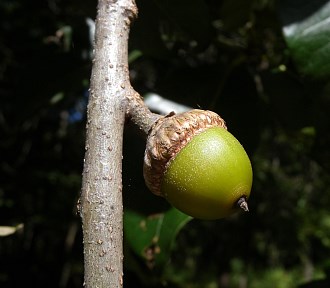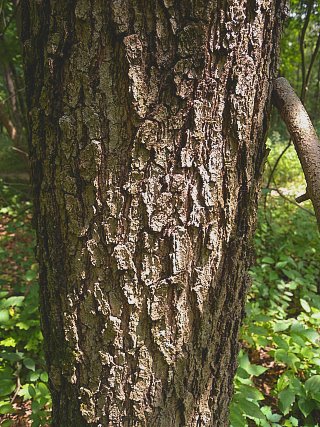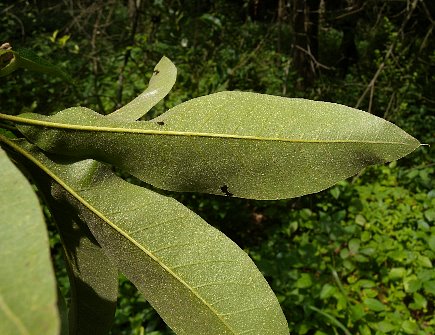
Shingle Oak is monoecious, producing separate male (staminate) and female (pistillate) flowers on the same tree. Male flowers are produced in drooping yellowish catkins about 3" long. Each male flower is less than 1/8" (3 mm.) across, consisting of an irregularly lobed calyx and several stamens. Female flowers occur near the tips of twigs as the vernal leaves unfold; either short clusters of 2-4 female flowers or individual female flowers are produced. Each female flower is less than ¼" long, greenish red, and ovoid in shape, consisting of an ovary, a calyx that surrounds the ovary, and 3 stigmata at the apex. Underneath each female flower, there are scale-like bractlets with downy hairs. The blooming period occurs during mid- to late spring for about 2 weeks; the flowers are cross-pollinated by wind. Afterwards, fertile female flowers are replaced by acorns that take 2 years to develop; they become mature during the autumn of the second year. Acorns usually occur along the twigs either individually or in clusters of 2; they have short woody pedicels. Mature acorns are about 10-15 mm. long and a little less across, consisting of a light brown cup and a brown nut. Each cup extends about one-third the length of an acorn. The meat of the acorn is bitter. The root system consists of a taproot with spreading lateral roots.

Cultivation: This tree prefers full or partial sun and moist to dry conditions; it adapts to many soil types, including those that contain loam, clay-loam, sand, and some rocky material. Good drainage is required. To a greater extent than other oak trees (Quercus spp.), the appearance of Shingle Oak is often marred by gall-making insects.
Range & Habitat: The native Shingle Oak is common in all areas of Illinois, except the NW section of the state, where it is largely absent (see Distribution Map). Illinois lies along the NW range-limit of this tree. Habitats consist of upland woodlands, well-drained areas of floodplain woodlands, wooded slopes and edges of bluffs, tall riverbanks, edges of limestone glades, sandstone cliffs, and fence rows. In addition to these habitats, Shingle Oak is occasionally cultivated as a landscape tree.

Faunal Associations: Insects that feed on the leaves, suck plant juices, bore through the wood, etc., of Shingle Oak and other oak trees (Quercus spp.) include larvae of metallic wood-boring beetles, larvae of long-horned beetles, larvae of bark beetles, leaf beetles, weevils, larvae of gall flies, larvae of sawflies, larvae of gall wasps, aphids, leafhoppers, treehoppers, armored scales, mealybugs, plant bugs, stink bugs, walkingsticks, larvae of Duskywing skippers (Erynnis spp.), larvae of Hairstreak butterflies (Satyrium spp.), and larvae of such moths as tiger moths, case-bearer moths, Geometer moths, leaf blotch miner moths, slug caterpillar moths, midget moths, owlet moths, prominent moths, giant silk moths, clear-winged moths, trumpet leaf-miner moths, and Tortrix moths (see the Beetle Table, Aphid Table, Moth Table, and Insect Table for more detailed information). These insects attract a variety of insectivorous birds, including the Scarlet Tanager, Summer Tanager, Carolina Chickadee, Prothonotary Warbler, Northern Parula, Cerulean Warbler, Yellow-throated Warbler, Blue-gray Gnatcatcher, Acadian Flycatcher, Yellow-throated Vireo, Red-eyed Vireo, Yellow-billed Cuckoo, and Tufted Titmouse (Gabbe et al., 2002). The acorns of Shingle Oak and other oak trees are an important source of food for many birds and mammals. Birds that feed on acorns include ducks, crows, blackbirds, woodpeckers, nuthatches, upland gamebirds, and parakeets (the extinct Carolina Parakeet and non-native Monk Parakeet). The Bird Table provides a more detailed list of these birds. Mammals that feed on acorns include the Gray Fox, White-tailed Deer, Prairie Vole, Meadow Vole, White-footed Mouse, Virginia Opossum, Raccoon, Southern Flying Squirrel, Eastern Gray Squirrel, Fox Squirrel, American Red Squirrel, Eastern Chipmunk, American Black Bear, and Muskrat (minor); White-tailed Deer also browse on the twigs and leaves of these trees, while the Cottontail Rabbit gnaws on the bark and twigs of saplings (Martin et al., 1951/1961; Hamerstrom & Blake, 1939; Whitaker, 1966; and Beeman & Pelton, 1980; Haugen, 1942). Oaks also provide protective cover for various kinds of wildlife. Birds that use oak trees as nest sites include the Red-shouldered Hawk, Cerulean Warbler, Hooded Warbler (saplings), Blue-gray Gnatcatcher, Eastern Wood-pewee, Yellow-throated Vireo, and Field Sparrow (saplings); see Dijak et al. (1990), Newell & Rodewald (2011), Bielefeldt & Rosenfeld (2001), and Best (1978). These trees are also used by bats as daytime roost sites and maternity colonies. Overall, the value of Shingle Oak and other oak trees to wildlife is very high.

Photographic Location: An upland area of Busey Woods in Urbana, Illinois.
Comments: Shingle Oak is one of two oaks (Quercus spp.) in Illinois that has leaves with smooth margins; other oaks have pinnatifid leaves. The other oak species with smooth-margined leaves, Quercus phellos (Willow Oak), is found in southern Illinois. The leaves of Willow Oak are more narrow (½" or less) than those of Shingle Oak. At one time, the wood of Shingle Oak was used to make wooden shingles for houses, hence the common name. Other common names for this tree are Jack Oak and Northern Laurel Oak.